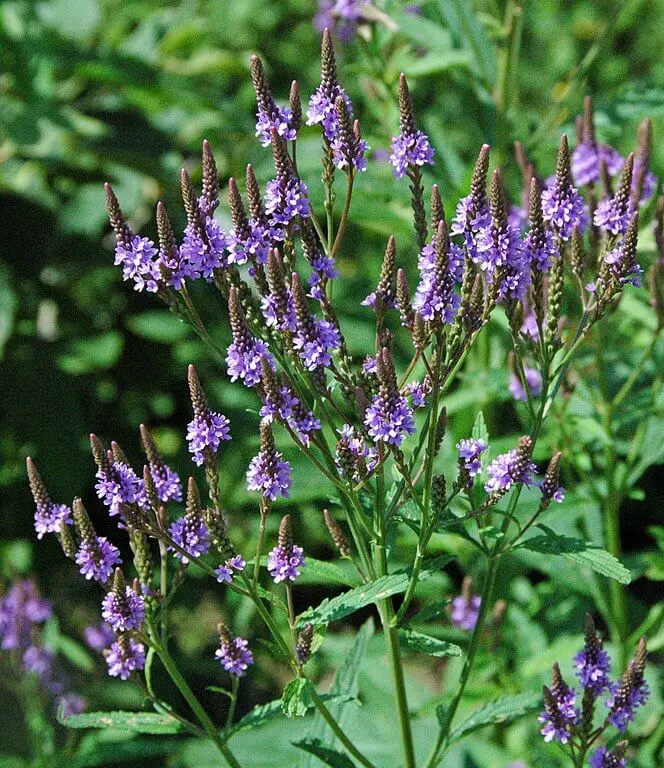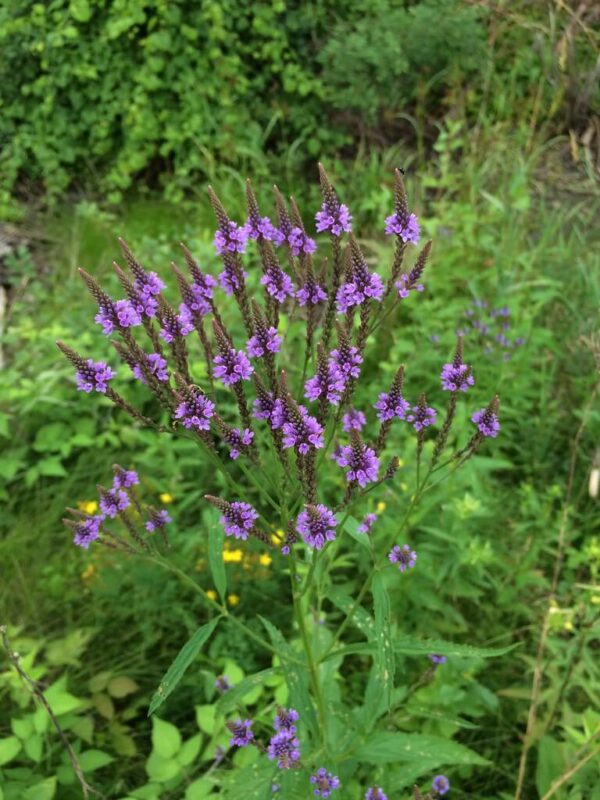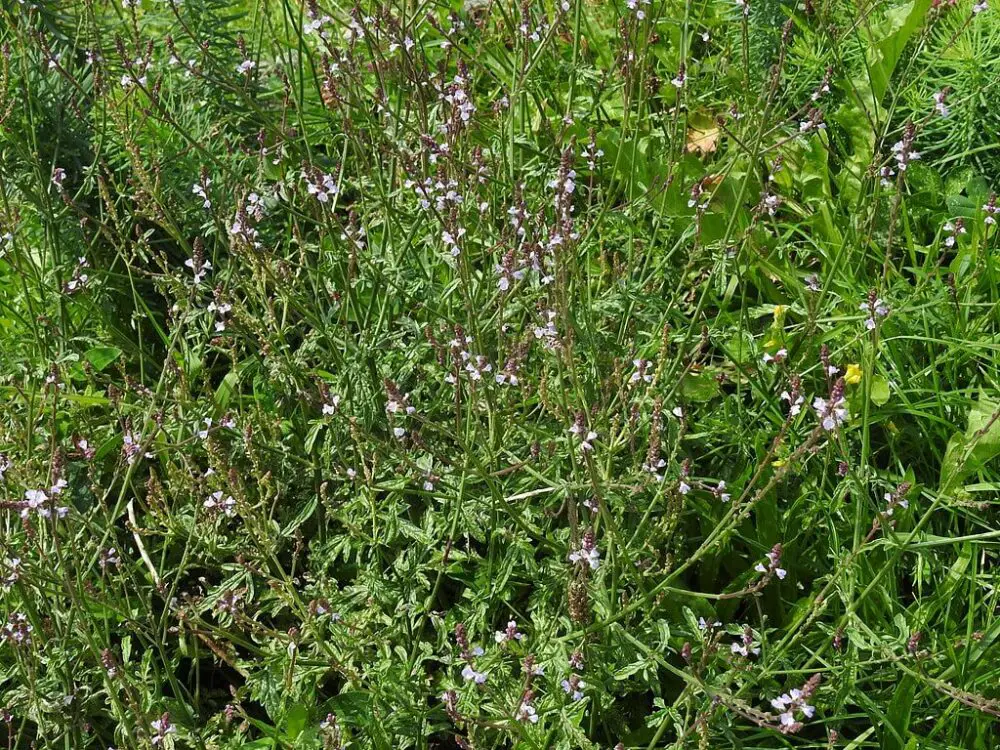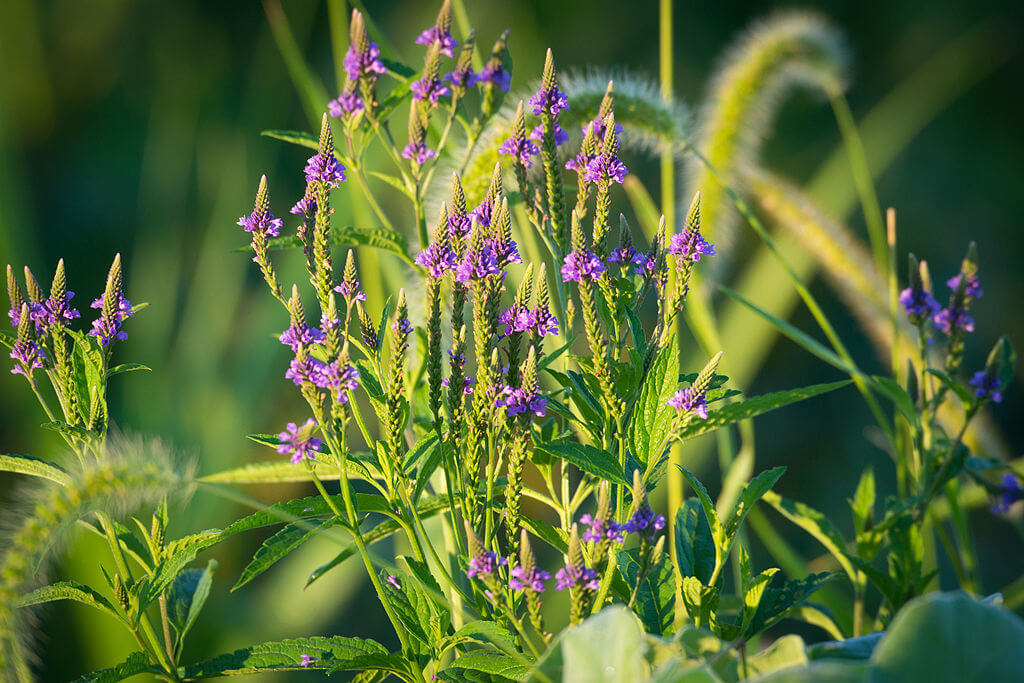Blue vervain, known by its scientific name Verbena hastata, is an attractive perennial with purple-blue spiky blooms. Because of its beautiful nature, many don’t realize that this wildflower is edible.
Blue Vervain (Verbena Hastata) Plant Profile
Verbena hastata can often be known by its common names:
- American vervain
- American blue vervain
- Blue vervain
- Swamp verbena
- Swamp vervain
- Wild hyssop
This flowering plant comes from the Verbenaceae family (vervain) and is a herbaceous perennial plant. That means it dies and returns to the ground yearly as the roots remain alive. It’s ready for new growth annually.
These wildflowers are essential in horticulture, whether grown individually or as part of a herbaceous border.
What Are You Foraging For Right Now?
We're thrilled to hear your ideas. What would you like to submit today? Feel free to share your thoughts and experiences with us.
Wildflowers from this genus usually bloom with 5-petalled, salver-shaped flowers that branch off spikes or panicles. The leaves are generally small and toothed or pinnately lobed.
This perennial is popular among foragers, gardeners, and pollinators with a showy nature and boomtime between early summer and fall. The buckeye butterfly also uses blue vervain as a larval host.
This wild plant always looks so good and grows so well because it is generally disease and pest-free.


Where Does Blue Vervain Grow?
Because blue vervain is a North American native plant, you’ll most often find it growing there.
This is a hardy wild plant growing in nearly every part of the United States. But, you’re unlikely to find it in USDA plant hardiness zone 8, as it prefers colder climates.
If you plan to grow blue vervain at home, this plant does best in partial to full sun and well-draining but moist, moderately rich soil.
In nature, you can find it growing in:
- Moist meadows
- Thickets
- Pastures
- Riversides
- Ditches
- Roadsides
- Marshes
- River-bottom prairies
How to Identify Blue Vervain
Vervain is one of the easiest wildflowers to recognize due to its striking and attractive tubular blue-violet flowers.
They form several pencil-esque flower spikes. These unique flowers sit on top of candelabra-style stems that branch upwards. You’ll notice that they sit atop tall, branched stems.
Blue vervain has simple but opposite leaves with double-serrate margins that stand on rigidly erect, branching square stems.
You can look for the purple, spiky flowers from midsummer to early fall, during its bloom time.

What is the Difference between Vervain and Blue Vervain?
Although both are part of the Verbenaceae family, these two wildflowers are different species of the vervain wildflower. So, don’t confuse Verbena officinalis (common vervain) and Verbena hastata (blue vervain).
With about 250 species in the Verbena genus, it’s no surprise that there will be similarities and differences.
The main differences to be aware of include:
- Common vervain is a native plant in Asia and Europe, whereas blue vervain is found growing most often in North America.
- Although both boast attractive purple flowers, the flowers of common vervain are silky, pale-purple, smaller, and less tubular than blue vervain.
- Look out for the leaves. The Verbena officinalis has lobed, toothed leaves. In contrast, blue vervain has oblong, opposite dark-green leaves with solid veins and a rough texture.


Is blue vervain Edible?
Yes, blue vervain is not poisonous and is generally considered a safe food to eat by the FDA.
Most commonly, the seeds are roasted and then ground into a powder. The leaves are often used for tea, salads, and soups.
How to Cook with Blue Vervain
There are several ways to cook with blue vervain, whether you have been lucky enough to find it fresh or you plan to buy and cook dried leaves and flowers (dried aerial parts).
Some of these cooking methods for blue vervain include:
- Steeping fresh leaves or dried aerial pieces in hot water to make tea.
- Roasting and grinding the seeds to make an edible powder (although this can be somewhat bitter).
- Tossing the leaves into soups or stew dishes to add extra flavor.
- Adding a flair or style and extra flavor to salads, desserts, and cocktails with a garnish of blue vervain leaves.
What part of Blue Vervain is Medicinal?
As far back as ancient times, the American blue vervain was believed to be a cure-all among medicinal plants. The genus name even gives this away, meaning ‘sacred plant.’
Both the roots and leaves have been often harvested all year as a medicinal part of the plant, as an expectorant, sudorific, emetic, or tonic to treat several health complaints.
Its medicinal purposes include:
- Intermittent fever
- Colds
- Obstructed menstruation
- Anorexia
- As recovery from acute diseases
- Strengthen organs
- Epilepsy
- Insomnia
- Headaches
- Stomach aches
- Sooth the nervous system
- Aid mental health problems such as depression and anxiety
- Blue vervain has even been known as an antidote to American Pokeweed poisoning
Check out our video for 5 plants to forage for better sleep, including blue vervain.
How to make ‘sleep-aid’ blue vervain tea
- Add 1 pint of boiling water to 1 tbsp. of dry blue vervain leaves.
- Steep for 10 min.
- Take 1 tbsp. up to six times a day and take 1/2 teacup (2 oz.) warm before bedtime.
When you look at the beautiful, hardy, and versatile nature of blue vervain, it should definitely be on your plant list or field guides.
How to make blue vervain tincture
- 1 ounce dried
- 5 ounces 80 proof alcohol (40% alcohol by volume)
Place the herb in a jar. Pour the alcohol over the dried blue vervain. Place the jar in a dark, room temperature area.
Let the tincture steep for 3-4 weeks and shake occasionally. Once ready, use a cheesecloth to filter out the herbs.
Getting into the great, wet outdoors in search of edible plants, herbs, fruits and fungi is one of Sarah’s favorite outdoor pursuits. She thinks there’s nothing better than combining her passion for hiking with the start of the foraging season. Sarah’s definitely not afraid of a little rain and dirt, it’s all part of the fun.

